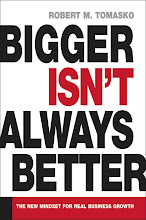December 03, 2008
When Microsoft got it right
Parallel paths are often the best way to avoid the paralysis that frequently accompanies single, bet-your-business strategies. Improvisers acting along these lines have many balls in the air at once. Rather than rushing to implement any single solution, they mimic the experimenter and launch multiple attacks on each problem.
This is what Microsoft did at a critical stage of its development when it had to be open to the leadings and promptings of a market that itself didn’t know where it was going.
In 1988 Microsoft was not the certain winner in the desk top operating system wars. Smaller then than most of its competitors, its flagship product DOS had been the industry standard for six years in the PC market, but it was clunky and showing its age. It’s replacement product, Windows, was already in its second release and a near still-birth attracting more pundit criticism than loyal users.
Facing-off with Microsoft in the marketplace was a much loved, more elegant alternative - the Apple Macintosh operating system. AT&T, Hewlett-Packard and Sun Microsystems were touting a new graphical version of their robust Unix software. And IBM had just released OS/2, a product compatible with DOS, as strong as Unix and as easy to use as a Macintosh.
How did Microsoft respond? With a little of everything. A new, improved DOS was put on the market along with the latest version of Windows. Microsoft actually co-developed OS/2, so it would share its market success along with IBM. In case Apple’s Macintosh triumphed, Microsoft invested heavily in updated versions of Excell, PowerPoint and Word that would run only on it. And, to keep its flanks protected, Microsoft even partnered with a small software maker to create a version of Unix that was PC-compatible.
The business press had a field day criticizing the company from Seattle. “Microsoft was adrift, Gates has no strategy” shouted the articles. Rumors abounded of infighting among rival teams of his programmers. Gates, of course, was far from strategy-less. He had a clear plan of action in the face of massive uncertainty. He, as McKinsey consultant Eric Beinhocker noted, bet on every horse. Gates wanted Windows to pull ahead in the race, but he knew that past trends were not predictors of future results in the then still-amorphous PC market (otherwise we’d all be using Macintoshes today). So he flanked his favored product with an array of side bets. Even if Windows lost, Microsoft wouldn’t.
That was a good strategy for Microsoft in 1988. But less so now as it tries to find its place in the internet in 2008.
A common problem of successful companies is they keep repeating the strategies that led to their success.
Link
This is what Microsoft did at a critical stage of its development when it had to be open to the leadings and promptings of a market that itself didn’t know where it was going.
In 1988 Microsoft was not the certain winner in the desk top operating system wars. Smaller then than most of its competitors, its flagship product DOS had been the industry standard for six years in the PC market, but it was clunky and showing its age. It’s replacement product, Windows, was already in its second release and a near still-birth attracting more pundit criticism than loyal users.
Facing-off with Microsoft in the marketplace was a much loved, more elegant alternative - the Apple Macintosh operating system. AT&T, Hewlett-Packard and Sun Microsystems were touting a new graphical version of their robust Unix software. And IBM had just released OS/2, a product compatible with DOS, as strong as Unix and as easy to use as a Macintosh.
How did Microsoft respond? With a little of everything. A new, improved DOS was put on the market along with the latest version of Windows. Microsoft actually co-developed OS/2, so it would share its market success along with IBM. In case Apple’s Macintosh triumphed, Microsoft invested heavily in updated versions of Excell, PowerPoint and Word that would run only on it. And, to keep its flanks protected, Microsoft even partnered with a small software maker to create a version of Unix that was PC-compatible.
The business press had a field day criticizing the company from Seattle. “Microsoft was adrift, Gates has no strategy” shouted the articles. Rumors abounded of infighting among rival teams of his programmers. Gates, of course, was far from strategy-less. He had a clear plan of action in the face of massive uncertainty. He, as McKinsey consultant Eric Beinhocker noted, bet on every horse. Gates wanted Windows to pull ahead in the race, but he knew that past trends were not predictors of future results in the then still-amorphous PC market (otherwise we’d all be using Macintoshes today). So he flanked his favored product with an array of side bets. Even if Windows lost, Microsoft wouldn’t.
That was a good strategy for Microsoft in 1988. But less so now as it tries to find its place in the internet in 2008.
A common problem of successful companies is they keep repeating the strategies that led to their success.
Link
